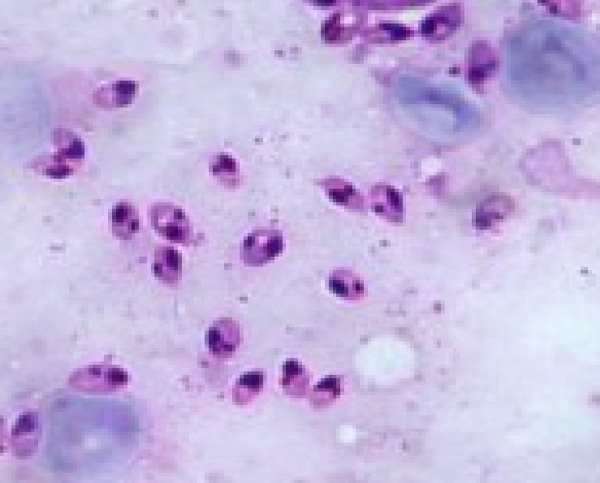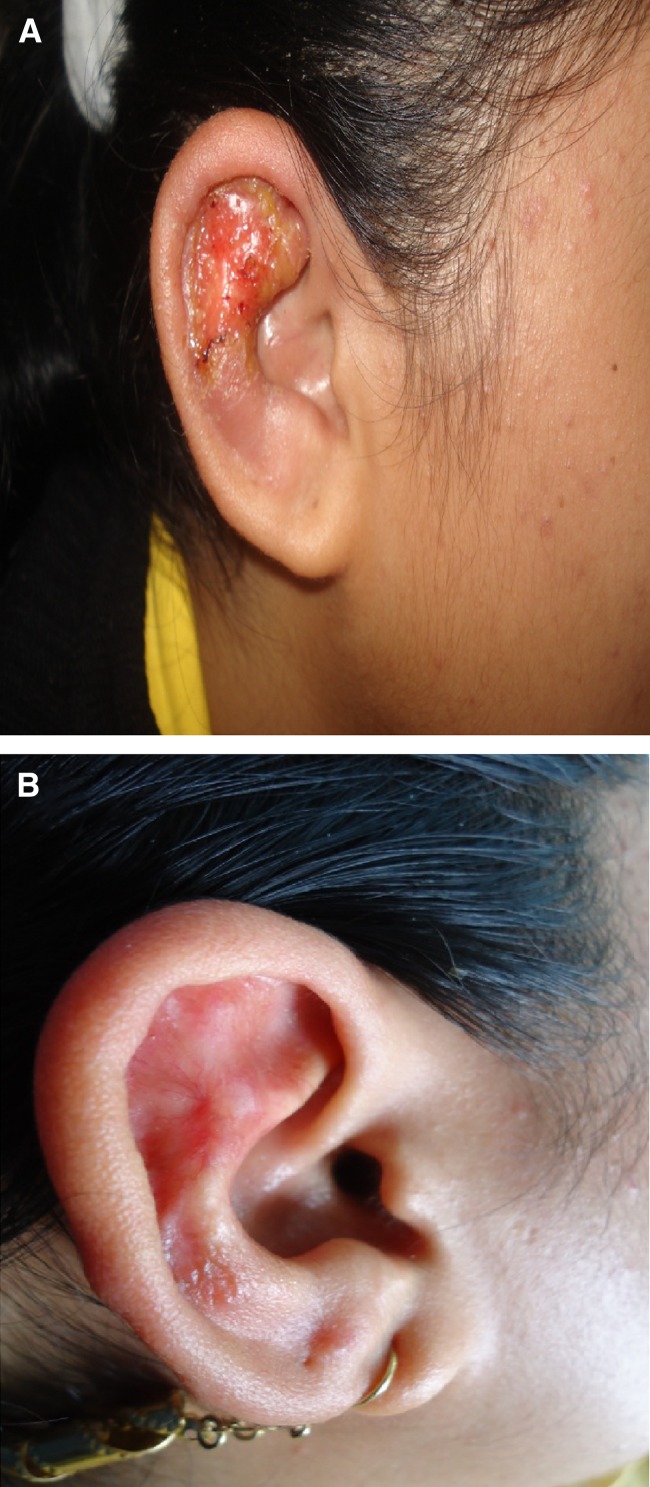Abstract
An 18-year-old female presented with a severe ulcerative lesion on her right ear of 6 weeks duration. Her right ear was edematous and erythematous with a large, painless ulcerative lesion covering a third of the pinna and satellite papular lesions on the posterior. She was diagnosed with chiclero's ulcer. A skin smear stained with Diff-quik showed abundant Leishmania parasites. Chiclero's ulcer is a rare clinical presentation and is typically severe and difficult to treat. Physicians in Ecuador recommend administering prolonged intramuscular Glucantime. Side effects are common and can be severe resulting in low patient compliance. Because of preferences of the patient and the large volume needed for her weight, we recommended topical treatment with a lotion of Glucantime mixed half and half with white Merthiolate. After applying this lotion to the lesion 3 to 4 times a day for 6 weeks, the lesion healed.
An 18-year-old female presented with a severe ulcerative lesion on her right ear of 6 weeks duration. The lesion began in December 2011 as an itchy papular mosquito bite that enlarged to a nodule and later formed an ulcerative lesion covering a large part of the auricle. The patient came from Puerto Quito-Pichincha, a subtropical rainforest located in the Pacific region of Ecuador, where cutaneous leishmaniasis (CL) is endemic.1 She visited a local physician who diagnosed erysipelas and prescribed oral ciprofloxacin and clindamycin for 10 days and fucidic acid as a topical ointment; however, the lesion showed no improvement. After completing 2 weeks of antibiotics she visited our department. The patient's right ear was edematous and erythematous with a large, painless ulcerative lesion covering a third of the pinna and satellite papular lesions on the posterior (Figure 1A). She was diagnosed with chiclero's ulcer. A skin smear stained with Diff-quik showed abundant Leishmania parasites (Figure 2). She was otherwise healthy. Her weight was 85 kg.
Figure 1.
(A) Lesion upon first clinical observation. (B) Resulting healed site of lesion after topical lotion.
Figure 2.

Leishmania bodies (amastigotes) present in a stained smear of the “chiclero's ulcer” specimen.
American tegumentary leishmaniasis is endemic in Ecuador and is reported in tropical and subtropical ecological regions from the Pacific side and Amazonian region; human cases are also diagnosed in some interandean valleys. Cutaneous leishmaniasis in Ecuador presents in several clinical variants, though the typical ulcerative form is most common. Other presentations such as nodular, pian bois, diffuse, recidiva cutis, erysipeloid, disseminated, and chiclero's ulcer are rare.2 The mucosal form is a very rare presentation in the subtropical regions of Pacific Ecuador and appears to be restricted to the Amazonian rainforest.
Most CL presentations are self-healing within a period of 6 to 12 months, except diffuse cutaneous and recidiva cutis. Chiclero's ulcer is a rare clinical presentation and is typically severe and difficult to treat, needing two or three schedules of intramuscular antimonial pentavalent. Physicians in Ecuador recommend administering prolonged intramuscular Glucantime. Side effects are common and can be severe resulting in low patient compliance. These side effects include myalgia, arthralgia, fever, asthenia, and anorexia. Because of preferences of the patient and the large volume (21 mL or 4 ampoules/day) needed for her weight, we recommended topical treatment with a lotion of Glucantime mixed half and half with white Merthiolate. After applying this lotion to the lesion three to four times a day for 6 weeks, the lesion healed (Figure 1B). Our goal is to report this unusual case of CL and its atypical yet effective topical treatment. Gathering the information for such a case and presenting it in a clinical image will serve for physicians to be aware of this cutaneous variant, demonstrate alternative treatment methods of CL, and augment the body of knowledge in this field.
Footnotes
Authors' addresses: Manuel Calvopiña, Departamento de Parasitología Molecular y Medicina Tropical, Centro de Biomedicina, Universidad Central, Quito, Ecuador, E-mail: manuelcalvopina@gmail.com. Leonardo Martinez, Global Community Health and Behavioral Sciences, Tulane University School of Public Health and Tropical Medicine, E-mail: lmartin7@tulane.edu. Yoshihisa Hashiguchi, Centro de Biomedicina, Universidad Central del Ecuador, Quito, Ecuador, PROMETEO Secretaria Nacional de Educacion Superior, Ciencia, Tecnologia e Inovacion (SENESCYT) Ecuador, and Department of Parasitology, Kochi Medical School, Kochi University, Nankoku City, Kochi, Japan, E-mail: yhashiguchi42@yahoo.co.jp.
References
- 1.Armijos RX, Weigel MM, Izurieta R, Racines J, Zurita C, Herrera W, Vega M. The epidemiology of cutaneous leishmaniasis in subtropical Ecuador. Trop Med Int Health. 1997;2:140–152. doi: 10.1046/j.1365-3156.1997.d01-236.x. [DOI] [PubMed] [Google Scholar]
- 2.Calvopiña M, Gomez EA, Uezato H, Kato H, Nonaka S, Hashiguchi Y. Atypical clinical variants in New World cutaneous leishmaniasis: disseminated, erysipeloid, and recidiva cutis due to Leishmania (V.) panamensis. Am J Trop Med Hyg. 2005;73:281–284. [PubMed] [Google Scholar]



